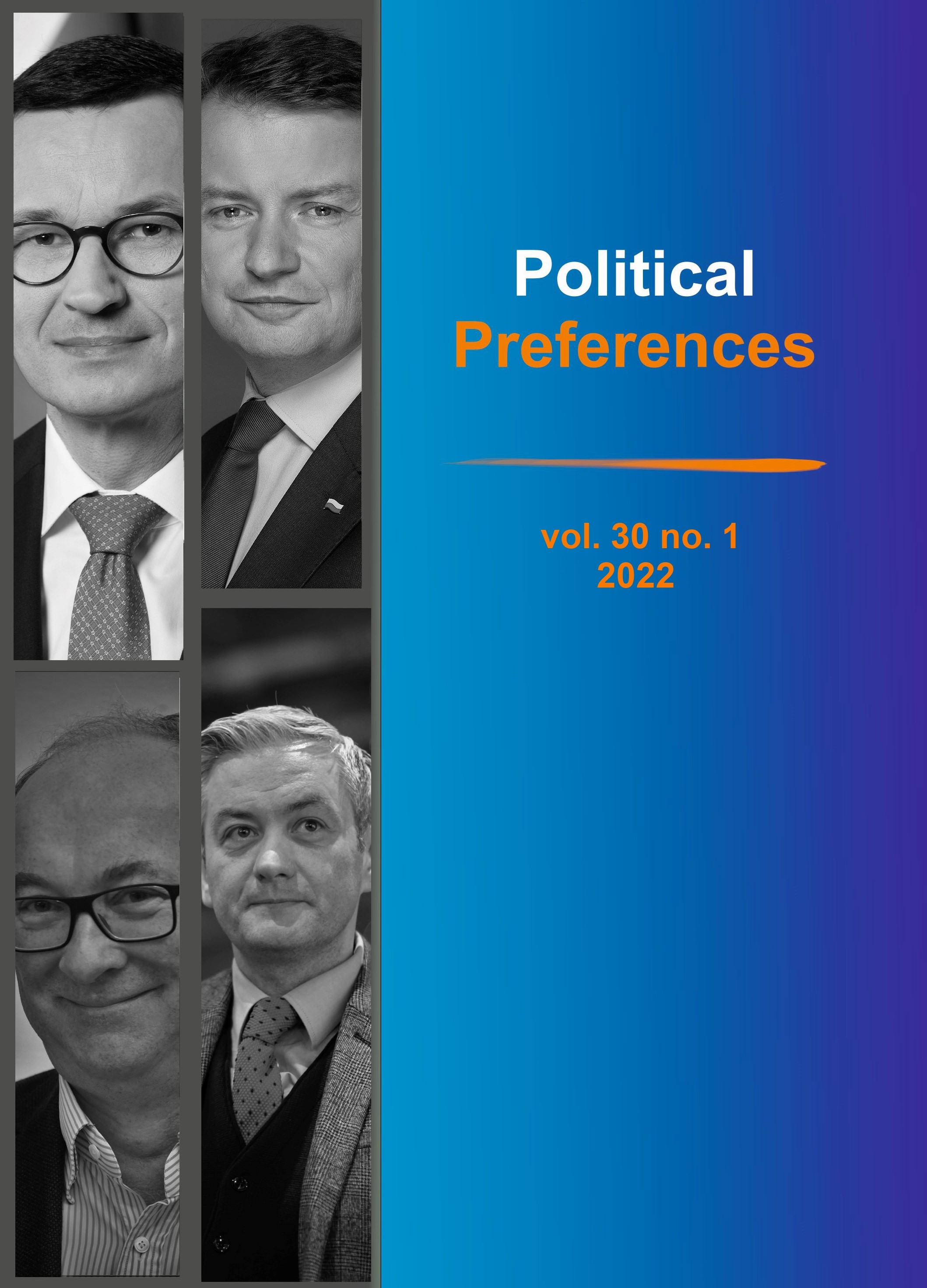Cwalina, W., Falkowski, A., & Kaid, L. L. (2000). Role of Advertising in Forming the Image of Politicians: Comparative Analysis of Poland, France, and Germany. Media Psychology, 2(2), 119–146. https://doi.org/10.1207/S1532785XMEP0202_2
Google Scholar
Cwalina, W., Falkowski, A., & Kaid, L. L. (2005). Advertising and the Image of Politicians in Evolving and Established Democracies: Comparative Study of the Polish and the U.S. Presidential Elections in 2000. Journal of Political Marketing, 4(2–3), 19–44. https://doi.org/10.1300/J199v04n02_02
Google Scholar
Falkowski, A., & Cwalina, W. (2012). Political Marketing: Structural Models of Advertising Influence and Voter Behavior. Journal of Political Marketing, 11(1–2), 8–26. https://doi.org/10.1080/15377857.2012.642705
Google Scholar
Garzia, D. (2014). Personalization of Politics and Electoral Change. Palgrave Macmillan.
Google Scholar
Gieracka, A. (2015, October 21). Triumf Adriana Zandberga. Ekspert ocenia debatę liderów. Interia. https://wydarzenia.interia.pl/raporty/raport-wybory-parlamentarne-2015/aktualnosci/news-triumf-adriana-zandberga-ekspert-ocenia-debate-liderow,nId,1907884
Google Scholar
Hloušek, V., & Kopeček, L. (2017). Entrepreneurial Parties: A Basic Conceptual Framework. Politologický Časopis - Czech Journal of Political Science, 24(2), 83–91. https://doi.org/10.5817/PC2017-2-83
Google Scholar
Kaid, L. L. (2004). Measuring candidate images with semantic differentials. In K. L. Hacker (Ed.), Presidential Candidate Images (pp. 231–236). Rowman & Littlefield.
Google Scholar
Kaid, L. L., & Chanslor, M. (1995). Changing Candidate Images: The Effects of Political Advertising. In K. L. Hacker (Ed.), Candidate Images in Presidential Elections. Praeger.
Google Scholar
Kaid, L. L., Postelnicu, M., Landreville, K., Hyun Jung Yun, & LeGrange, A. G. (2007). The Effects of Political Advertising on Young Voters. American Behavioral Scientist, 50(9), 1137–1151. https://doi.org/10.1177/0002764207300039
Google Scholar
Kaniewska-Sęba, A., & Pawełczyk, P. (2020). Temperatura uczuć młodych Polaków wobec wybranych polskich polityków. Wrocławskie Studia Politologiczne, 28, 91–104. https://doi.org/10.19195/1643-0328.28.6
Google Scholar
Karpieszuk, W. (2019, November 20). Efekt Zandberga: przemówienie hitem internetu. Popularniejsze niż exposé premiera. Wyborcza.pl. https://warszawa.wyborcza.pl/warszawa/7,54420,25430340,efekt-zandberga-przemowienie-hitem-internetu-popularniejsze.html
Google Scholar
Karvonen, L. (2010). The personalisation of politics: A study of parliamentary democracies. ECPR Press.
Google Scholar
Kosowska-Gąstoł, B., & Sobolewska-Myślik, K. (2017). New Political Entrepreneurs in Poland. Politologický Časopis - Czech Journal of Political Science, 24(2), 137–157. https://doi.org/10.5817/PC2017-2-137
Google Scholar
Kowalska, D. (2021, May 6). Czarzasty, Biedroń i Zandberg, czyli trzej tenorzy polskiej lewicy. Polska Times. https://polskatimes.pl/czarzasty-biedron-i-zandberg-czyli-trzej-tenorzy-polskiej-lewicy/ar/c15-15598783
Google Scholar
Marmola, M. (2019). New Parties in the Party Systems of Central and Eastern European Countries: The Factors of Electoral Success. Athenaeum. Polskie Studia Politologiczne, 63, 50–65. https://doi.org/10.15804/athena.2019.63.04
Google Scholar
Marmola, M. (2020). Nowe partie w systemach partyjnych państw Grupy Wyszehradzkiej. Adam Marszałek.
Google Scholar
Mazur, M. (2014). Polityka z twarzą: Personalizacja parlamentarnych kampanii wyborczych w Polsce w latach 1993-2011. Wydawnictwo Uniwersytetu Śląskiego.
Google Scholar
Metz, M., Kruikemeier, S., & Lecheler, S. (2020). Personalization of politics on Facebook: Examining the content and effects of professional, emotional and private self-personalization. Information, Communication & Society, 23(10), 1481–1498. https://doi.org/10.1080/1369118X.2019.1581244
Google Scholar
Newman, B. I. (1999). The mass marketing of politics: Democracy in an age of manufactured images. Sage Publications.
Google Scholar
Newman, B. I., & Sheth, J. N. (1985). A Model of Primary Voter Behavior. Journal of Consumer Research, 12(2), 178–187.
Google Scholar
Nimmo, D. (1975). Images and Voters’ Decision-Making Processes. Advances in Consumer Research, 2, 771–781.
Google Scholar
Olszanecka-Marmola, A. (2019). The Effects of Political Advertising on the Perception of Political Images: A Case Study of Polish Presidential Election in 2015. Political Preferences, 22, 43–58.
Google Scholar
Olszanecka-Marmola, A. (2020). Czy telewizyjna reklama polityczna może zmienić wizerunek kandydata? Adam Marszałek.
Google Scholar
Olszanecka-Marmola, A., & Marmola, M. (2021). Gender Differences in Reactions to TV Political Advertising: An Empirical Study of the 2015 Presidential Election in Poland. Annales Universitatis Mariae Curie-Skłodowska, Sectio K – Politologia, 27(2), 109. https://doi.org/10.17951/k.2020.27.2.109-125
Google Scholar
Osgood, C. E., Suci, G. J., & Tannenbaum, P. H. (1957). The measurement of meaning. University of Illinois Press.
Google Scholar
Peszyński, W. (2016). Prezydencjalizacja zachowań wyborczych w elekcji parlamentarnej w 2015 roku. Political Preferences, 12, 37–55.
Google Scholar
Pilawa, K. (2020, June 16). Robert Biedroń – pigułka programowa. Kandydat wszystkich, czyli nikogo. Klub Jagielloński. https://klubjagiellonski.pl/2020/06/16/robert-biedron-pigulka-programowa-kandydat-wszystkich-czyli-nikogo/
Google Scholar
Rahaṭ, G., & Kenig, O. (2018). From party politics to personalized politics? Party change and political personalization in democracies (First edition). Oxford University Press.
Google Scholar
Rahat, G., & Sheafer, T. (2007). The Personalization(s) of Politics: Israel, 1949–2003. Political Communication, 24(1), 65–80. https://doi.org/10.1080/10584600601128739
Google Scholar
Schill, D., & Kirk, R. (2014). Courting the Swing Voter: “Real Time” Insights Into the 2008 and 2012 U.S. Presidential Debates. American Behavioral Scientist, 58(4), 536–555. https://doi.org/10.1177/0002764213506204
Google Scholar
Szczęśniak, A. (2021, October 8). Wyborcy Lewicy chcą Zandberga na lidera. Ekspertka: „Konieczne jest nowe rozdanie”. OKO.Press. https://oko.press/wyborcy-lewicy-chca-zandberga-na-lidera/
Google Scholar
Turska-Kawa, A., & Olszanecka-Marmola, A. (2016). A Woman in Politics or Politics in a Woman? Perception of the Female Leaders of Polish Political Parties in the Context of the 2015 Parliamentary Election. Communication Today, 7(2), 66–77.
Google Scholar
Wattenberg, M. P. (1987). The Hollow Realignment: Partisan Change in a Candidate-Centered Era. Public Opinion Quarterly, 51, 58–74.
Google Scholar


 https://doi.org/10.31261/polpre.2022.1.5-18
https://doi.org/10.31261/polpre.2022.1.5-18

 10.31261/polpre
10.31261/polpre